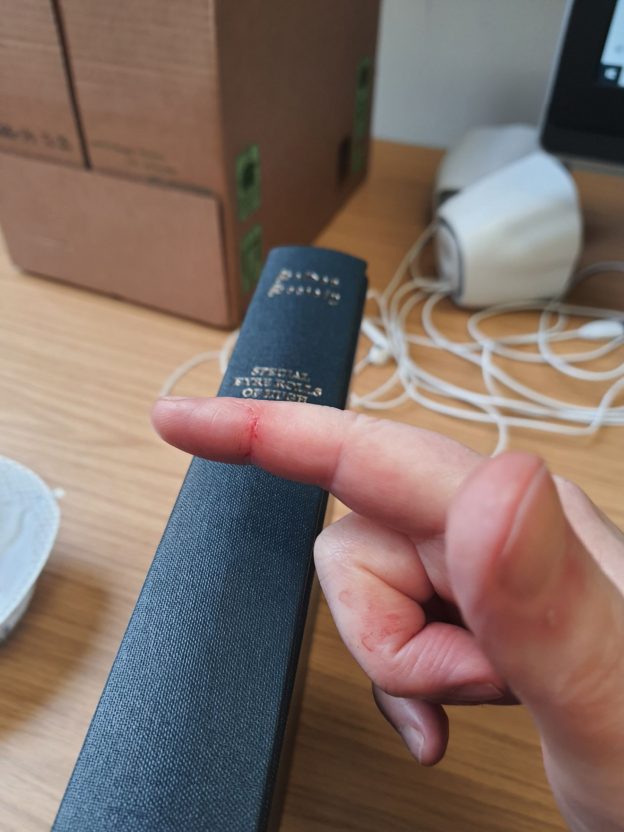A very brief comment this time, but this Middlesex entry from the King’s Bench plea roll for has got me thinking …
It’s one which has some bearing on my mayhem project, but also resonates with other areass which interest me – women, assessment of injury, and no doubt more.
The entry notes that Katherine de Coresle was attached to answer the king and Thomas de Slene in a plea of contempt and trespass. Thomas complained that, on the Saturday after the feast of the Ascension, 31 Edward III, attacked Thomas with force and arms, i.e. with stones etc.,[i] in Westminster Hall, in the presence of the king and his justices, hurting him (Thomas, not the king), in contempt of the king and damaging Thomas to the extent of ten pounds.
Katherine denied everything, pleaded not guilty. She put herself on the country. Thomas did likewise. The jury said that Katherine was guilty of the trespass, and set damages at 6s 8d. Having viewed Thomas’s wounds, the court decided that the jury had been very mean, and raised the damages to 20s. Katherine was to be taken into the custody in the Marshalsea prison.
I have not found any additional information on this, so far, but it certainly seems an arresting incident (assuming that it happened … obviously, we can never be sure, but this does sound like something which was supposed to have been done in such an open manner that a lot of people would have to have been lying through their teeth – or something else fairly outrageous would have to have been going on – for the jury to come to the conclusion that Katherine was guilty of inflicting the wounds Thomas was confirmed to have sustained). If it is true, then, we have to get our heads around the idea of a woman lobbing stones at a man, hard enough to cause serious harm, within Westminster Hall, apparently without concern for the august personages also present there.
Another thing which leaps out is the differences between the various sums put forward as appropriate damages for Thomas’s injuries. We have:
- the sum Thomas claimed – ten pounds
- the sum awarded by the jury – six shillings and eight pence
- the sum awarded to Thomas after the court inspected his injury – twenty shillings.
… or, if we feed this information into the National Archives currency converter (one of my absolute favourite things …) that would be (roughly …): (i) 27 cows/50 days of wages for a skilled tradesman; (ii) no cows but 16 days of wages for a skilled tradesman; (iii) 2 cows/50 days of wages for a skilled tradesman. (I assume that the reason that the maths looks a bit odd is that it is assumed you would not be able to buy seven tenths of a cow …). It does suggest a high degree of both over-claiming and under-valuation by juries. There is so much to think about, in terms of how sums of money were attached to particular offenders, victims and injuries – hard to say much at the moment, but I am compiling a bit of a database … slowly! It does always strike me as interesting that there is a level of confidence amongst common lawyers that a court is capable of assessing somebody’s level of injury. Worth bearing in mind in the history of the development of medical expertise/ forensic medicine.
GS
11/3/2022
Image: some stones. In case anyone is not sure what they look like …
Photo by Michael Surazhsky on Unsplash
[i] The stones might have been fictitious/conventional, but they were not the usual weapons/projectiles encountered in trespass weapons lists, so I don’t think it’s too much of a stretch to think that they actually meant that stones were involved.





